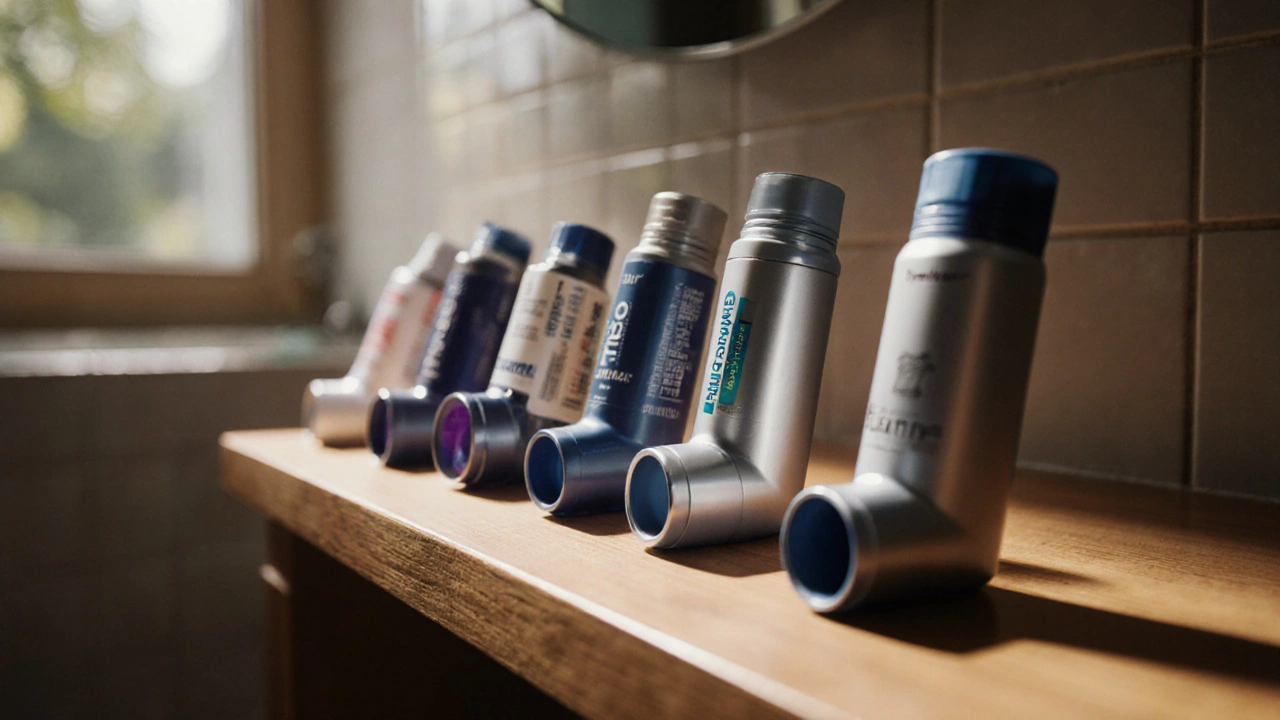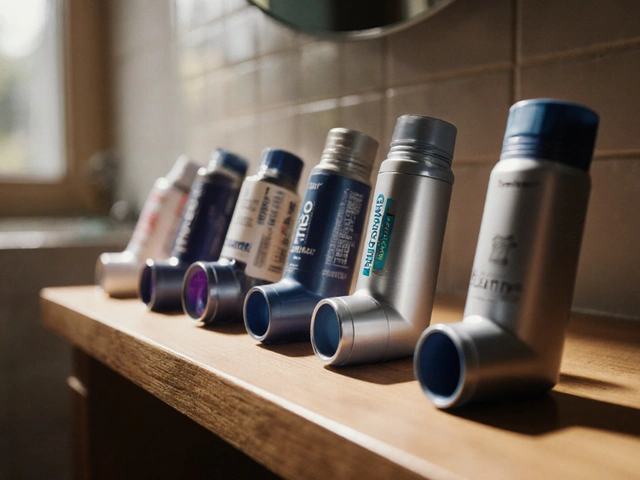Symbicort vs. Other Inhalers: Interactive Comparison Tool
Symbicort
Budesonide
Formoterol
MDI Device
$120–$150/month
Advair
Fluticasone
Salmeterol
MDI / DPI
$130–$160/month
Breo Ellipta
Fluticasone
Vilanterol
DPI Device
$140–$170/month
Pulmicort
Budesonide
DPI Device
$80–$110/month
Dulera
Mometasone
Formoterol
MDI Device
$115–$145/month
Albuterol
Albuterol
MDI Device
$30–$45/month
Select an inhaler above to view its comparison with Symbicort.
Quick Takeaways
- Symbicort combines an inhaled corticosteroid (Budesonide) with a long‑acting beta‑agonist (Formoterol) for twice‑daily control.
- Advair and Breo Ellipta offer similar steroid/bronchodilator pairings but differ in dosing frequency and device type.
- Pulmicort provides only Budesonide - good for mild asthma but lacks bronchodilator support.
- Dulera pairs Mometasone with Formoterol, a slightly stronger steroid but the same LABA.
- Cost and insurance coverage vary widely; generic Budesonide/Formoterol inhalers can be cheaper than branded combos.
Choosing the right inhaler can feel like navigating a maze of acronyms and dosage charts. If you’re weighing Symbicort against other options, you need clear criteria: how fast it works, how often you have to use it, side‑effect profile, and, of course, price. This guide breaks down the most common alternatives, lines them up side‑by‑side, and helps you decide which device fits your daily routine.
What is Symbicort?
Symbicort is a combination inhaler that contains Budesonide, an inhaled corticosteroid (ICS), and Formoterol, a long‑acting beta‑agonist (LABA). It is approved for maintenance treatment of asthma and chronic obstructive pulmonary disease (COPD). The device delivers a metered‑dose spray (MDI) that patients typically use twice daily.
How Symbicort Works
Budesonide reduces airway inflammation by suppressing cytokine production, while Formoterol relaxes smooth muscle to keep airways open for up to 12 hours. The two agents act synergistically, giving better symptom control than using either component alone.

Key Factors to Compare Inhalers
- Active ingredients: Which steroid and LABA are used?
- Device type: Press‑metered inhaler (MDI) vs. dry‑powder inhaler (DPI).
- Dosing frequency: Once daily, twice daily, or as needed.
- Indications: Asthma, COPD, or both.
- Cost: Brand price vs. generic equivalents.
- Side‑effect profile: Risk of oral thrush, tremor, tachycardia, etc.
Common Alternatives
Below are the most frequently prescribed inhalers that compete with Symbicort for asthma or COPD management.
Advair
Advair pairs Fluticasone propionate (ICS) with Salmeterol (LABA). Available as a dry‑powder inhaler (DPI) and a metered‑dose inhaler, it is usually taken twice daily.
Breo Ellipta
Breo Ellipta combines Fluticasone furoate (ICS) with Vilanterol (LABA). The DPI is designed for once‑daily use, which appeals to patients who want fewer daily steps.
Pulmicort
Pulmicort contains only Budesonide (ICS). It is a dry‑powder inhaler taken twice daily and is suitable for mild‑to‑moderate asthma when a bronchodilator is not needed.
Dulera
Dulera delivers Mometasone furoate (ICS) and Formoterol (LABA). Like Symbicort, it is an MDI used twice daily, but the steroid component is considered slightly more potent.
Albuterol (Rescue)
Albuterol is a short‑acting beta‑agonist (SABA) used for immediate relief of bronchospasm. It is not a maintenance medication but often paired with any of the above inhalers for breakthrough symptoms.
Side‑by‑Side Comparison Table
| Inhaler | ICS + LABA | Device | Dosing Frequency | Typical Cost (US$) per month | Common Side Effects |
|---|---|---|---|---|---|
| Symbicort | Budesonide+Formoterol | MDI | Twice daily | ≈$120-$150 | Oral thrush, hoarseness, tremor |
| Advair | Fluticasone+Salmeterol | MDI / DPI | Twice daily | ≈$130-$160 | Thrush, headache, palpitations |
| Breo Ellipta | Fluticasone+Vilanterol | DPI | Once daily | ≈$140-$170 | Throat irritation, cough, tachycardia |
| Pulmicort | Budesonideonly | DPI | Twice daily | ≈$80-$110 | Oral thrush, dysphonia |
| Dulera | Mometasone+Formoterol | MDI | Twice daily | ≈$115-$145 | Thrush, hoarseness, jitteriness |
| Albuterol | SABA only | MDI | As needed | ≈$30-$45 | Tremor, rapid heartbeat, nervousness |

Pros and Cons: Symbicort vs. Each Alternative
- Symbicort vs. Advair: Both use an MDI and require twice‑daily dosing, but Symbicort’s Formoterol has a faster onset (about 1‑2minutes) which can double as a reliever, whereas Salmeterol takes longer to kick in.
- Symbicort vs. Breo Ellipta: Breo’s once‑daily regimen is convenient, but the higher lung‑deposition of the DPI may be harder for patients with coordination issues. Symbicort offers more flexibility with a quick‑acting LABA.
- Symbicort vs. Pulmicort: Pulmicort lacks a LABA, so patients often need a separate rescue inhaler. Symbicort provides both control and quick relief in one device, reducing the number of inhalers carried.
- Symbicort vs. Dulera: Dulera’s steroid (Mometasone) is slightly more potent, which could mean lower dose for severe asthma, but Formoterol is identical, so efficacy is comparable.
- Symbicort vs. Albuterol: Albuterol is a rescue only; it can’t replace daily maintenance. Symbicort’s dual action covers both maintenance and symptom relief, but patients still need a SABA for sudden attacks.
How to Choose the Right Inhaler for You
- Assess severity: Mild intermittent asthma may only need a low‑dose ICS like Pulmicort. Moderate‑to‑severe disease often requires an ICS/LABA combo such as Symbicort or Advair.
- Consider device handling: If you struggle with hand‑breath coordination, a DPI (Breo, Pulmicort) might feel easier than an MDI.
- Frequency matters: Patients who forget doses appreciate once‑daily options (Breo). If you prefer a quick‑onset LABA, Formoterol in Symbicort gives faster relief.
- Insurance and cost: Check your formulary. Generic Budesonide/Formoterol inhalers can be up to 30% cheaper than brand‑name combos.
- Side‑effect tolerance: If you experience frequent oral thrush, rinsing the mouth after each use and possibly switching to a slightly different steroid (Mometasone in Dulera) can help.
Ultimately, the best inhaler is the one you’ll use correctly every day. Talk with your healthcare provider, compare out‑of‑pocket costs, and test the inhaler technique during a pharmacy visit.
Frequently Asked Questions
Can I use Symbicort as a rescue inhaler?
Yes, Formoterol has a rapid onset (1‑2minutes), allowing Symbicort to serve as both maintenance and quick‑relief in many treatment plans, but you should still have a short‑acting rescue inhaler for severe attacks.
Is there a generic version of Symbicort?
Yes, several manufacturers produce generic Budesonide/Formoterol inhalers that are therapeutically equivalent and usually cost 20‑30% less than the brand.
What’s the main difference between Budesonide and Fluticasone?
Both are inhaled corticosteroids, but Fluticasone tends to have a slightly higher potency per microgram, while Budesonide is often better tolerated by patients prone to throat irritation.
How often should I clean my inhaler?
For MDIs like Symbicort and Advair, wipe the mouthpiece with a clean cloth weekly. For DPIs such as Breo, keep the device dry and avoid moisture; replace the inhaler when the dose counter reaches zero.
Can I switch from Symbicort to a DPI without loss of control?
Switching is possible, but you’ll need a step‑down or step‑up plan supervised by your clinician to ensure the new device delivers the same corticosteroid dose and LABA exposure.








Abhishek A Mishra October 7, 2025
Hey folks, I was looking through the Symbicort guide and it got me thinkin about how the fast onset of Formoterol could actually cut down on the need for a separate rescue inhaler, which is pretty handy.
I also noticed the price range $120‑$150 a month, that’s a bit steep for many, especially if you don’t have good insurance.
Definately worth checking if a generic Budesonide/Formoterol combo is available, they can be 20‑30% cheaper.
Also, make sure you rinse your mouth after each puff to avoid that thrush thing.
If you’re on a tight budget, ask your pharmacist about patient assistance programs, they can help you recieve the meds you need.
Darlene Young October 7, 2025
When you weigh Symbicort against its competitors, the first thing to examine is the pharmacologic profile of the LABA component.
Formoterol, unlike Salmeterol, reaches its peak bronchodilatory effect within one to two minutes, which essentially gives you a built‑in rescue option without adding another device to your bag.
That rapid onset can improve adherence because patients feel immediate relief and are less likely to skip doses.
The inhaled corticosteroid in Symbicort, Budesonide, has a slightly lower glucocorticoid potency per microgram compared with Fluticasone, but it is often better tolerated in the oropharynx, leading to less irritation for some users.
Budesonide also has a high first‑pass hepatic clearance, which reduces systemic exposure and may lower the risk of adrenal suppression over long‑term use.
Cost is another decisive factor; while the brand‑name Symbicort sits at roughly $120‑$150 per month, several pharmacies now stock generic Budesonide/Formoterol inhalers that can drop the price to the $80‑$100 range.
Insurance formularies frequently place the generic in a lower tier, meaning lower copays for patients with high deductible plans.
However, not all insurers treat the generic as interchangeable, so it’s worth calling your benefits administrator to confirm coverage.
From a device perspective, the metered‑dose inhaler (MDI) offers a familiar “press‑and‑inhale” action that many patients have mastered since childhood, but it does require proper hand‑breath coordination and regular cleaning of the mouthpiece to prevent bacterial buildup.
If coordination is an issue, a dry‑powder inhaler (DPI) such as Breo Ellipta may be easier, though you sacrifice the rapid‑onset Formoterol advantage.
Side‑effect management is simple but essential: rinse and gargle after each use, and consider using a spacer if you notice persistent thrush or hoarseness.
For patients prone to tremor or palpitations, start with the lowest effective dose and titrate up under medical supervision.
Finally, personal preference plays a non‑trivial role.
Some users appreciate the once‑daily convenience of Breo Ellipta, while others value the flexibility of a twice‑daily regimen that can be split between morning and evening activities.
Ultimately, the best choice is the inhaler you can use correctly every day, and Symbicort’s blend of fast‑acting LABA and tolerable corticosteroid makes it a strong contender for many moderate‑to‑severe asthma or COPD patients.
Discuss these options with your pulmonologist to tailor therapy to your lifestyle and clinical needs.
Jaylynn Bachant October 7, 2025
Choosing an inhaler feels a bit like picking a compass for a journey through a foggy forest; the device you trust shapes the way you navigate each breath.
One could argue that speed of relief mirrors how quickly we confront our inner doubts, while the steroid component whispers the quiet patience needed for long‑term growth.
In the end, the best choice is less about the label on the canister and more about the rhythm it sets for your daily existence.
Tom Lane October 7, 2025
Symbicort’s quick‑acting LABA really cuts down on extra rescue inhalers.
Anuj Ariyo October 7, 2025
I get where you’re coming from, the fast acting part is definitely a plus, but don’t forget to think about the cost, the device type, and your insurance coverage, all of which can change the overall experience, especially if you have to juggle multiple meds.
Kayla Rayburn October 8, 2025
Hey there, if you’re still on the fence about Symbicort versus the other combos, try writing down the pros and cons for each-like dosing frequency, side‑effects, and price-and bring that list to your next appointment. Your doctor can help you weigh the medical facts against what fits best into your daily routine.
Dina Mohamed October 8, 2025
Great idea!; a simple list can really clear the mental clutter; it also shows your provider that you’re engaged and proactive; plus, seeing everything side‑by‑side often reveals the hidden winner you might have missed.
Kitty Lorentz October 8, 2025
I hear you its tough juggling meds and bills but you dont have to do it alone reach out to a pharmacy tech they can sometimes find discounts or samples
inas raman October 8, 2025
Yo, totally get it-talking to the pharmacy can surprise you, they might have a good generic or a coupon that slashes the price big time.
Jenny Newell October 8, 2025
From a pharmacoeconomic standpoint, the incremental cost‑effectiveness ratio of Symbicort versus generic budesonide/formoterol remains marginal, especially when factoring in adherence metrics.
Kevin Zac October 8, 2025
Exactly, the real‑world adherence data suggest that patients on a twice‑daily MDI often display better peak expiratory flow consistency compared to once‑daily DPI regimens, which can influence the overall cost‑utility analysis.
Stephanie Pineda October 8, 2025
Thanks for all the insights! I’m leaning toward trying a generic combo first to see if the cost savings hold up, and I’ll keep the dosing schedule simple so I don’t miss doses. If it doesn’t work, I know I have a solid backup plan with the brand‑name options.